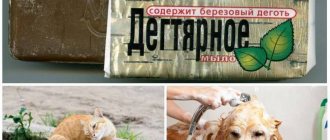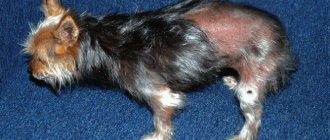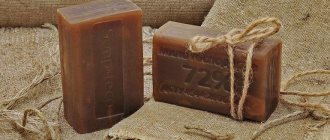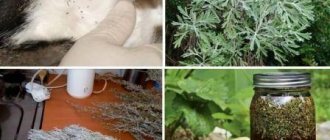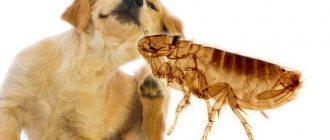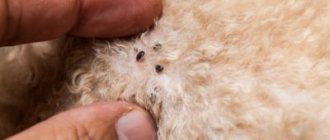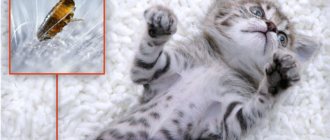Benefits and harms for dogs
Deciding whether you can wash your dog with tar soap or not is easier if you know the advantages and disadvantages of the folk remedy. Let's list the most important of them.
pros
Tar soap is unique and useful for pets according to the following criteria:
- Natural composition. The absence of aggressive chemical components ensures the dog’s safety from poisoning and skin burns. You can wash newborn puppies and pregnant bitches with soap.
- Wound healing effect. Scratches and flea bites on the body quickly heal. Tar soap is recommended by veterinarians for open wounds, dermatitis and eczema.
- Relieves itching from head lice. After a bath with tar soap, the dog stops itching and the skin calms down.
- Does not cause allergies. Cases of a negative reaction to tar are extremely rare. Allergies may occur to thickeners and fragrances. Change the brand and the negative effect will disappear.
- There are no side effects. Bathing in tar foam does not cause drowsiness, nausea, or vomiting. Chemical insecticides cannot boast of such an effect.
- Does not dry out the skin. The oils in tar soap do not disturb the water-salt balance of the dermis, even moisturize the pet’s skin and relieve inflammation from areas bitten by fleas.
- Can be used repeatedly. Chemical antiparasitic shampoos are recommended to be used no more than once a month. You can wash an adult dog with tar soap 2-3 times a week.
Minuses
Tar soap has few disadvantages. They can be easily tolerated by the dog and the owner.
- Unpleasant aroma. The smelly smell disappears from the body, furniture and bedding 2-3 hours after bathing the dog. But it is this effect that helps get rid of fleas.
- Soap suds cause a burning sensation on the mucous membrane. Make sure that the detergent does not come into contact with your pet's eyes, mouth or nose.
- Does not affect flea larvae. Flea eggs must be dealt with separately using a fine comb or chemicals. If you leave the larvae on the dog until they are fully mature, sanitary measures will have to be repeated again.
Application for dogs
Wash the dog with tar soap to get rid of fleas and ticks. But tar does not destroy them, it only scares them away. As soon as the smell disappears, the parasites return to their “favorite place” and continue to torment the pet. Therefore, the effectiveness of tar is low. Vet pharmacies have a large selection of more effective products in the form of sprays and drops.
It does not dry out the skin as much as household products, but with frequent use it will also lead to dermatitis. Also, your pet may not like the strong smell.
You cannot rub your pet's fur with a bar. Crumble the detergent and mix with warm water to a “liquid slurry” consistency. Then do the same as with regular shampoo - apply to the coat, lather and rinse.
Before the water procedure, do not forget to place lumps of cotton wool in your pet’s ears. They will protect against water and foam. Lubricate the corners of your eyes with Vaseline before bathing.
Symptoms of fleas in domestic cats
The following signs will help you determine that the animal is bothered by fleas and not by any disease:
- skin itching. The poor animal begins to scratch its back and sides. Ticks usually infect the ear and groin areas;
- the presence of flea waste products. You can see excrement and flea eggs, which outwardly resemble a mixture of white and dark grains, by parting the cat’s fur;
- adult fleas. Parasites actively begin to flee from the animal’s body when washing or combing, and this is where you can see them with your own eyes;
- wounds, ulcers, redness of the skin. Flea bites themselves irritate the cat's skin, and subsequent scratching leads to the formation of various lesions.
Treatment should begin if at least one of the above symptoms is present. After all, inconspicuous-looking fleas can cause serious health problems for your pet:
- infections;
- baldness;
- disorders of the nervous system.
It is very important to start treatment on time and try to remove fleas without harm to the health of your pet. The following flea remedies will help you in the fight against this scourge: Stronghold, Advocate, Advantage, Inspector, Frontline, Bars and Celandine.
Advantages and disadvantages
The advantages of tar soap include the following factors:
- Safety. The use of tar soap is allowed even in the case of small kittens. It is used to treat pregnant cats and dogs. Many chemicals cannot be applied to open wounds because... they corrode the skin and can cause infection. Tar is not an aggressive drug.
- Overall effect. Soap not only acts on fleas - it improves the condition of the pet's skin and well-being.
- Price. Tar soap is inexpensive and can be used several times. As a result, 1 treatment is 10-20 times cheaper than using drops on the withers.
- Possibility of prevention. Soap can be used to provide protection to the animal if you are going to visit a potentially dangerous place, such as a forest. Sprays are preferable because... They are most effective against large concentrations of parasites, but they are not suitable for weakened pets. The smell of tar will repel insects for a short period of time.
- Easy to use. Other than having to wash your pet, soap is easy to use. It's easier than applying essential oils or herbal infusions to the coat. After treating with tar, you will not have to leave the apartment for several days, as is the case with many insecticidal preparations.
Most often, when highlighting the advantages and disadvantages, tar is compared with its analogues: dust and laundry soap.
The disadvantages include the following factors:
- Relatively low efficiency. It is not always possible to remove fleas using tar. In case of severe infection, comprehensive measures are required, because... Some parasites may remain. If fleas have taken over an entire room, soap will not help.
- The need for repeated treatments. To increase reliability, a cat or dog is bathed several times.
- Presence of odor. It is weaker than when using professional insecticides, but stronger than from drops on the withers. Odors from clothing, wool and furniture may not cause discomfort to humans, but they are critical for animals. After bathing, cats are able to hiss at each other without recognition.
- The need to wash the pet. For owners of small dogs, this most often does not cause any inconvenience. It is difficult to bathe a large dog, and cats often show aggression.
Soap has very strong antibacterial properties.
Tar soap for fleas on dogs
Due to the fact that most dogs love to bathe, the procedure is easier than with a cat; no assistant is needed. Soap with tar can even be used on puppies; it is harmless to them.
Dogs are larger than cats and have longer and thicker fur, so lathering and rinsing will take longer. And due to the fact that they regularly go outside and come into contact with other animals, infection occurs frequently.
Important! For dogs whose sense of smell is a working tool, it is not recommended to use any strong-smelling substances. This means that tar soap is not suitable for a bloodhound! Owners noted that the smell of tar repels parasites and infections occur less frequently than before using it
Many owners use tar soap for preventive purposes.
The owners noted that the smell of tar repels parasites and infections occur less frequently than before using it. Many owners use tar soap for preventive purposes.
Rules for washing a dog with tar soap
The method of using products with tar is the same as for cats:
- The dog is washed with water at a comfortable temperature, the entire body is heavily soaped except for sensitive areas (eyes, nose, ears).
- Leave for 10 minutes (wrapped in a soft cloth).
- Afterwards, carefully rinse and wipe until semi-damp.
- They destroy parasites on the face and ears (by pressing).
- Comb out the larvae.
How many times should you wash your dog without harming its health?
To rid your dog of fleas, repeat the treatment procedure 2-3 times, every 4 days. Next, check the animal for the presence of parasites - if there are fleas, you need to repeat.
There have been cases when a heavily infected animal was treated up to 8 times in a row. Soap not only cleansed the skin, healed wounds and pustules, it made the skin and coat softer and more tender.
In the warm season, when walks are more frequent, preventive bathing with tar soap is performed every 2 weeks.
Consequences of using it to wash dogs
Laundry soap effectively removes dirt. But along with it, the layer of fat that protects the pet’s skin from pathogenic microbes is also washed away. The destruction of the protective barrier entails the entry of infections into the body.
Exposure to alkali leads to dermatitis or eczema. Diseases develop due to the fact that the detergent greatly dries out the skin.
Also on the list of unpleasant consequences:
- the appearance of dandruff;
- hair loss;
- dull color of the cover.
In an emergency case of severe contamination and lack of suitable shampoo on hand, you can use laundry soap once. But for regular bathing procedures, purchase shampoo from a line suitable for your pet from a veterinary pharmacy.
Dog washing rules
It is not possible to get rid of head lice in a dog using tar soap in one go. Repeat the treatment of your pet 2-3 times, that is, every 3 days. Before washing, prepare everything you need:
- 2 pieces of soap and a container for foaming the product (basin, ladle);
- comb for combing out insects;
- a tall jar for collecting fleas;
- large towel.
Now you can start washing. If you live outside the city, in a private house, wash your dog outside. In an apartment, use a shared bath, but then disinfect the room and rugs 2-3 times.
- Fill a container with water for your dog's bath. Puppies are afraid of deep baths, use a regular basin.
- Place a bar of soap in water and shake with your hand to create foam.
- Bring your dog and put him in the water. If she is afraid or resists, fasten the nervous pet on a leash to a radiator or tap.
- Pour the soap solution over the animal. Massage your entire body, don't forget about your armpits, feet, and ears. If it doesn't foam well, run a bar of soap on the lower belly, along the withers and paws. Massage thoroughly again.
- Keep the dog in the foam for 5-7 minutes. The dog will be unhappy, persuade him, distract him.
- Rinse the wool with clean water.
- Now you can comb out the fleas with a comb. Place insects in a jar. A low container will not work; fleas will jump out of it. You will have to scratch for 20-30 minutes.
- Douse your pet with clean warm water. There should be no foam on the wool.
- Dry the dog with a towel and inspect the fur again. If you notice parasites, comb again.
- After washing, make sure the dog's bedding is clean. Buy a new one in advance or disinfect the old one.
Common Misconceptions About Using Soap for Dogs
When asked whether it is possible to wash a dog with regular soap, many give a positive answer. It is believed that an animal can be washed with any means, but tar and baby soap, when used frequently, dry out the pet’s delicate skin and fur, causing hair loss and dandruff. A similar effect appears after using human shampoos and shower gels.
For animals, you should use special dog shampoos. The manufacturer of pet products "Clandestine" produces tar soap specifically for dogs with moisturizing additives and a lower alkali content.
Another common misconception is that animals can be washed with dust soap; it kills fleas and ticks well. This product should not be used on dogs. It contains pesticides that can poison your pet.
Anti-parasite application for dogs
How to use this soap correctly? There are several steps that you can follow to get the most out of the product:
- Apply tar soap thoroughly to the cat's fur until a rich foam forms. Take this matter with special care if you have a furry pet. Be sure to ensure that the product does not get into your cat’s ears or eyes.
- Now spread the tar soap against fleas over the entire coat, not missing even hard-to-reach areas of the body. Don't forget to massage the product into your skin.
- Let the product remain on your pet for several minutes. This is necessary so that the foam has time to saturate the fur, skin and reach all hidden parasites. In the meantime, it’s worth keeping your pet busy so that he doesn’t start licking the tar soap.
- Now you can wash off the product with warm water. At the same time, it is recommended to use a fine-tooth comb to comb out as many fleas as possible from the fur.
And getting rid of fleas can be a real problem for both the owner and his pet. One trick can help here. It is better to start the procedure not in the bathroom itself with a lot of water. At the sight of a shower, cats simply begin to break out. In order not to injure the unfortunate animal, dilute tar soap with a small amount of water and carry out all manipulations in a dry basin or on a towel. And only then, when washing off the foam, can you use water.
Tar soap does not help against fleas instantly. The effectiveness of this grandmother’s remedy lies in the regularity of procedures. Only frequent use of tar soap will rid your pet of the entire population of parasites. How often should you bathe your cat in soapy water? Usually the treatment is repeated after ten days.
How to use soap correctly:
- avoid contact of the substance with the eyes;
- try to carry out the processing procedure in a well-ventilated area;
- in case of allergic reactions in an animal, do not re-treat;
- Do not use the product for people with allergies.
Rules for bathing dogs with soap:
- Prepare a soap solution.
- Treat animal fur.
- Rub the substance into the skin.
- Leave the product on for 10 minutes.
- Rinse thoroughly with warm water.
- Dry with a towel.
When bathing a large dog, use enough water. Typically, water treatments for dogs take a little longer because 2-3 treatments are required.
When destroying fleas from an animal, you need to do this in the room itself. If parasites were found on a pet, then they have already managed to hide in secluded places in the home. It is very difficult to catch these small insects, so careful treatment of the room is required.
Rules for processing the premises:
- Wear gloves and a respirator.
- Move furniture away from wallpaper and baseboards.
- Make a warm soap solution with thick foam.
- Apply the resulting mixture liberally to baseboards, door and window frames, window sills, radiators and openings.
- Leave the solution for 10 minutes.
- Rinse off the substance with warm water.
- Ventilate the room and do not enter the room until the smell disappears.
After treating the room, you can add a couple of drops of lavender oil to the aroma lamp. This will help further protect the room from fleas.
Pregnant women are not recommended to be present while the premises are being treated with soapy water to avoid chemical poisoning.
How to deal with fleas indoors
It is necessary to understand that even after fleas leave the animal's fur, they can live in another place for some time. Also, these parasites can feed on human blood for a long time, and the development of small larvae will occur in various bad places - in garbage, in dust particles, etc.
Therefore, even if you rid your pet of parasites with tar soap, but they remain in the room, they may still return, and everything will start all over again. To avoid such a situation, measures should be taken after removing parasites from the animal.
The necessary steps are:
- Carrying out a thorough disinfestation of the apartment using special insecticidal agents, with the help of which the premises are treated from parasites, and do not remove fleas from the fur of animals;
- Thorough cleaning of areas of the room with high humidity and other dirty places, followed by sprinkling them with insecticidal dust (to destroy insect larvae).
A conclusion about the success of using tar soap and some of the measures taken can be made if there are no “symptoms of the presence of fleas” for about a week after the most recent bathing.
To prevent parasites from attacking your pet again, it is best to take him out for walks wearing a collar. The pet should not be burdened, so it is better for a dog or cat to walk around the house without a collar.
Anti-parasite application for dogs
Bathing dogs is much easier - they love water treatments. You can do this without an assistant.
Rules for bathing dogs with soap:
- Prepare a soap solution.
- Treat animal fur.
- Rub the substance into the skin.
- Leave the product on for 10 minutes.
- Rinse thoroughly with warm water.
- Dry with a towel.
When bathing a large dog, use enough water. Typically, water treatments for dogs take a little longer because 2-3 treatments are required.
Rules for processing premises
When destroying fleas from an animal, you need to do this in the room itself. If parasites were found on a pet, then they have already managed to hide in secluded places in the home. It is very difficult to catch these small insects, so careful treatment of the room is required.
Rules for processing the premises:
- Wear gloves and a respirator.
- Move furniture away from wallpaper and baseboards.
- Make a warm soap solution with thick foam.
- Apply the resulting mixture liberally to baseboards, door and window frames, window sills, radiators and openings.
- Leave the solution for 10 minutes.
- Rinse off the substance with warm water.
- Ventilate the room and do not enter the room until the smell disappears.
After treating the room, you can add a couple of drops of lavender oil to the aroma lamp. This will help further protect the room from fleas.
Pregnant women are not recommended to be present while the premises are being treated with soapy water to avoid chemical poisoning.
Composition and properties
Pharmacy soap contains about 8-10% tar. Sometimes you can find homemade bars on sale. They often contain a higher proportion of the main ingredient.
Additionally, the composition includes the following substances:
- Alkalis. They help achieve the desired consistency when making soap. They enhance the effects of tar and facilitate the removal of parasites.
- Acids. Negatively affects insects. Fleas are killed along with the tar.
- Sodium salts. Maintains skin acid balance. Prevents excessive drying.
The smell repels insects, and the benzene contained in the bars causes paralysis. If you use soap together with other anti-flea products, this will enhance the effect: it will be easier for toxins to penetrate under the shell.
Sometimes pet owners have a question: is it possible to wash cats with tar soap? This soap is suitable for all cats because it is not an insecticide.
The product contains:
- birch tar (a natural substance that accelerates wound healing and has an antiseptic effect);
- phenol and alkali (have the ability to destroy pathogenic microorganisms, fungi, and burn insects);
- sodium salts (help maintain the electrolyte balance of the epidermis, prevent increased peeling);
- citric acid (repels fleas).
The following auxiliary components are used: water, stabilizers, thickeners, etc. The product affects only adult individuals (repels due to a specific odor), but does not get rid of parasite larvae or their eggs.
The product has useful properties:
- disinfects;
- dries;
- accelerates wound healing.
Soap can be in the form of bars (it lathers poorly, it is recommended to soak before use) or liquid (it is more convenient to use, but may contain surfactants that increase the dryness of the epidermis in case of frequent use).
What is the effectiveness of tar soap in fighting fleas?
Let's make a reservation right away: tar soap does not kill fleas, but repels them. Among the negative properties, the smell should be noted, although for many people, the aroma of tar is not irritating. By the way, the smell of tar soap is one of the decisive properties that warns insects that “this dog is unfit for food.” Of the main components that make up soap, we need to highlight:
- Alkali and phenol - burns the body of insects and microbes, provoking the coagulation of proteins. Microbes die after treatment with tar soap, and fleas actively “retire”. The substances do not kill the insect, its body is protected by a shell, and phenol and alkali do not harm the eggs of parasites.
- Birch tar - contains benzene, which paralyzes the nerve ganglia of fleas. After poisoning, the parasites become lethargic and move chaotically.
- Salts protect the epithelium from moisture loss, which is extremely important for the dog’s delicate skin.
Does tar soap help against fleas? How does it work?
Tar soap effectively destroys fleas - this is confirmed by numerous reviews. The product treats the skin after parasite bites. Its main advantage is safety for the animal and the owner. Even pregnant cats and kittens can be treated with this substance. People use this drug to kill lice.
The principle of operation of the product is simple - the active components of the soap paralyze the nerve centers of parasites, stopping their vital functions. The main ingredients of the drug destroy fleas and have a healing effect on the skin after bites of harmful insects. Very rarely, the drug causes minor side effects.
After bathing an animal with tar soap, its skin and fur may dry out a little. By licking the remaining substance after a hygiene procedure, the cat or dog will not have any unwanted reactions. If your pet lives in an apartment, then the rooms must be treated against insects.
Degtyarnoe
Among all cosmetics, this substance is the most affordable and effective. Tar soap resembles laundry soap in appearance, but with a sharper odor. The amount of tar in one piece is approximately 10%.
Fleas feed on human blood, and the smell of tar repels them. Fleas bite animals severely and for them it is unbearable pain, because wounds form on the pet’s body. Cats scratch wounds with their claws and thereby cause inflammation. Tar soap not only destroys parasites, but also relieves skin inflammation.
Dustovoe
This is a common household toxic substance that can kill fleas. In a certain concentration, it can kill parasites even in eggs, and not just in adults. The dust substance is effective because it destroys even larvae. Insects either leave the hairline or die if they remain on it.
It is enough to treat the animal with this drug once to rid it of parasites. Often using dust soap against fleas on dogs is not recommended due to increased toxicity.
Economic
Inexpensive detergent with a wide range of applications. Laundry soap was previously used to wash dishes, body and head, or wash clothes. This substance is also used to combat parasites. But soap does not kill them, but repels them with its smell.
Composition of the drug:
- potassium or sodium salt;
- fatty acid.
Laundry soap is an environmentally friendly and natural product. The product foams well even in cold water.
With celandine
Together with tar soap, you can use laundry soap or modern insecticides. For example, bathe the animal immediately with soap and then with a special anti-parasite shampoo. Complex treatment ensures that the fleas die.
The whole secret of the effectiveness of this product lies in its smell. The pungent aroma simply repels the hated insects that cause discomfort to the poor animal. In addition, according to pet owners, Grandma’s remedy is remarkable because it not only drives away adult animals, but also destroys the eggs and larvae of pests.
Consequences of using soap to wash dogs
Tar soap is not a very suitable product for bathing dogs, especially for frequent washing. It is used to solve a specific problem - flea control. The strong, pungent smell of soap can repel parasites, but the aroma of tar is also unpleasant for animals.
Specialized shampoos for dogs
The alkali in the product causes burning of the mucous membranes and their irritation, so the pet must be washed carefully so that foam does not get into the eyes, nose, ears and mouth. Soap destroys the protective fat film, which causes dry skin and coat. With frequent use, dermatitis and dandruff appear.
Note! For dogs, it is better to use special shampoos from pet stores that are designed for animals.
Video: various flea medications: which is more effective?
Good to know:
Comfortis flea tablets Fleas and ticks cause a lot of inconvenience to both pets and their owners. If an animal suffers from skin insects, the situation cannot be neglected. After all, fleas and ticks not only drink the blood of animals, but also carry dangerous diseases that can be transmitted to people. Fleas are carriers of helminth eggs – intestinal parasitic worms. If such a flea gets into the gastrointestinal tract, what means of protecting cats from fleas are applicable? The cat flea (lat. Ctenocephalides felis) is a dangerous blood-sucking parasite of domestic animals. They cause feline dermatophiliasis, which appears as raised, itchy growths on the skin. Repeated scratching of such ulcers leads to the appearance of pustular wounds, which contribute to infection of the animal’s blood. A massive attack by these parasites can cause anemia and exhaustion of a pet. Using essential oils for fleas in an apartment Fleas in a house or apartment are a big nuisance for both people and animals. After all, these blood-sucking insects not only leave unpleasant sensations after their bites, but also carry a number of dangerous diseases. Review of flea drops Advantage Advantage is a medicinal insecticide aimed at combating blood-sucking insects of domestic animals. Available in the form of drops on the withers for cats and dogs. The manufacturer is a well-established German company. The product is produced in convenient bottles - pipettes with a screw cap. Celandine in the form of drops against fleas for cats and dogsClandestine is a series of anti-flea medications intended for a wide range of people who keep pets. These drugs are united by effectiveness and accessibility, which is of significant importance when choosing antiparasitic drugs. Celandine flea drops are especially popular. Reviews from numerous satisfied pet lovers confirm this.
Common Misconceptions
People think that you can bathe a dog using baby soap - supposedly it is harmless. But what is good for guys is not safe for puppies. Human skin is different from dog skin. Our reactions to chemicals are also different. A gentle amount of alkali in baby detergent is harmless to babies, but dries out your pet's skin. As a result, itching, dandruff and irritation appear.
A popular misconception also applies to dust soap. It is used to poison parasites - in order to get rid of insects, it is more effective than tar. But using dust soap for cats and dogs is prohibited. Its main component is poison that will poison your friend.
Composition, effectiveness and beneficial properties
Tar soap is used not only to combat fleas in cats and dogs, but also in the treatment of various dermatological diseases. And although there are now a large number of antiparasitic drugs on the market, the folk remedy is in demand. It includes the following components:
- Birch tar is a natural component that has antiseptic and wound-healing properties. It contains benzoyl, which has a detrimental effect on the receptors of parasitic insects.
- Sodium salts help maintain the water-salt balance of the epidermis and prevent its excessive peeling.
- Alkali and phenol cause burns to parasites and can destroy fungi and pathogens.
- Citric acid can repel fleas.
Auxiliary components include water, thickeners, stabilizers and other substances. Birch tar, which is part of the composition, gives a specific smell and dark brown color.
The product does not contain insecticides and cannot kill insects, although it has a negative effect on them. It is effective against adults, but does not help get rid of eggs and larvae, since the specific smell simply scares the parasites away from the animal. For application to give positive results, soap alone is not enough.
From the name it becomes clear that soap contains tar. Thanks to this resinous product, a dark, unusual shade and a specific smell appear. At first glance, this is a lack of soap. However, it is the smell that becomes a powerful blow that hits the fleas. In addition to tar, soap contains active ingredients such as lye and fat.
The drug contains the following ingredients:
- Birch tar. Natural antiseptic. Helps destroy pathogenic organisms and fungi. No insects can tolerate this smell and die from exposure to tar.
- Sodium salts. They normalize the water balance of the skin and help in the treatment of dermatitis.
- Phenol, cresol, acids and alkalis. They “burn out” the parasites and do not give them any chance of survival.
Additional properties and distinctive features of the tar preparation:
- Brown color;
- dries hair and fur;
- helps with seborrhea and scabies, soothe itching and relieve inflammation;
- has a wound-healing and antibacterial effect;
- does not foam well;
- relieves itching after insect bites.
The low price determines the popularity of the drug, and one piece is enough for several baths for a medium-sized animal. This product can be used as an alternative to expensive synthetic insecticides. If the animal has too many parasites, you can use special anti-flea preparations along with soap.
Composition and properties of tar soap
The main components of tar soap:
- birch tar (accounts for ten percent of the total mass of the substance) is a natural component that has an antiseptic natural effect. Thanks to its action, all pathogenic microorganisms, microbes, and pathogenic fungi die. It relieves itching and has a slightly analgesic effect. Insects cannot stand its smell, so after washing the animal, the smell scares them away for a long time;
- sodium salts keep the water-salt balance of the skin normal;
- phenol, cresol, and alkali contained in soap cause chemical burns to parasites.
Our grandmothers used tar soap for fleas, and some still believe that this is the best and time-tested remedy. In addition, tar soap has some very significant advantages.
- Availability and low price, about 20 rubles per piece; specialized chemical preparations for fleas cost tens of times more.
- Safety for both animals and people.
- Does not cause allergic reactions with frequent use.
Soap also has some disadvantages: the first is a rather pronounced specific smell, and the second is that this product does not affect parasite eggs, so it is necessary to carry out secondary treatment after 4-5 days. Also, not all animals love water treatments, so be patient.
What can be used in combination with tar soap?
To get rid of unpleasant roommates, you can deal them a complex blow using tar soap and other means. For example, the following crops will help with this:
Sagebrush. The smell of this herb is also unpleasant for fleas. A bunch of wormwood should be used to sweep the floors or spread twigs throughout the house. It is also necessary to use a decoction. Lavender and eucalyptus oil. These products are effective due to their scent. Oils have a wide range of uses. They can be placed in an aroma lamp, dripped onto wool or diluted in water, and then sprayed from a spray bottle around the apartment or on animals, unless, of course, they are afraid of such manipulations. Garlic and geranium have the same effect as tar soap against fleas. Cats, unfortunately, may experience poisoning after using them.
Therefore, these products should be used with caution. That is, garlic and geranium can be placed in places where pets do not go
Tar soap has always been used to get rid of fleas and as a preventive measure. If you regularly wash your furry pets with it, then no insects will ever settle in their fur. If you don’t want to spend money on chemicals and want to save your family budget, then tar soap will be a real salvation.
Flea tar
Rules for using the product:
- Place the cat or kitten in a cup, thoroughly moisten its fur.
- Apply tar flea shampoo with massage movements, rubbing into the pet’s skin. Particular care should be taken to lather the product in the abdomen, withers, and folds of the paws.
- Wrap the animal in a dry towel and maintain this exposure for 10 minutes. The maximum time that a soap solution can remain in the fur is 40 minutes, but it is rare that a cat can be kept lathered for such a long period.
- Wash the cat with warm water and remove all remaining product. Some of the surviving fleas in the water scatter and therefore you should be prepared for physical violence against the parasites.
- Dry the fur with a dry towel and, once completely dry, use a comb to comb out any remaining fleas.
- In case of severe infestation, repeated treatment is carried out after 3-5 days.
Tar soap for fleas in dogs is used according to the same principle as in cats. Unlike meowing dogs, they willingly undergo water procedures and the process of removing parasites will not cause difficulties for their owners.
Bathing with tar soap
Tar soap is used against fleas in the apartment. It is added to water for washing floors, treating walls, washing cat and dog accessories. It will not only help destroy insects, but also thoroughly disinfect surfaces from germs and mold. For the same purposes, green soap is used to destroy garden pests.
How to use the drug
Tar for fleas
Tar for fleas in cats and dogs is available in the form of solid, liquid soap, and shampoo. To treat cats, it is more convenient to use tar soap in liquid form, as it foams better and the bathing process will go faster. If you use traditional hard flea soap, it is recommended to first soak a bar of soap in water until a thick foam forms. It is allowed to use flea medication in kittens over 5 weeks old, weakened and sick cats.
Rules for using the product:
- Place the cat or kitten in a cup, thoroughly moisten its fur.
- Apply tar flea shampoo with massage movements, rubbing into the pet’s skin. Particular care should be taken to lather the product in the abdomen, withers, and folds of the paws.
- Wrap the animal in a dry towel and maintain this exposure for 10 minutes. The maximum time that a soap solution can remain in the fur is 40 minutes, but it is rare that a cat can be kept lathered for such a long period.
- Wash the cat with warm water and remove all remaining product. Some of the surviving fleas in the water scatter and therefore you should be prepared for physical violence against the parasites.
- Dry the fur with a dry towel and, once completely dry, use a comb to comb out any remaining fleas.
- In case of severe infestation, repeated treatment is carried out after 3-5 days.
Tar soap for fleas in dogs is used according to the same principle as in cats. Unlike meowing dogs, they willingly undergo water procedures and the process of removing parasites will not cause difficulties for their owners.
Bathing with tar soap
On a note!
Often, pet owners use laundry soap against fleas. But it does not have such a pronounced effect as soap with the addition of birch tar. It is advisable to use laundry soap for fleas in cats if your pet is allergic to tar.
Tar soap is used against fleas in the apartment. It is added to water for washing floors, treating walls, washing cat and dog accessories. It will not only help destroy insects, but also thoroughly disinfect surfaces from germs and mold. For the same purposes, green soap is used to destroy garden pests.
Important!
Pregnant women and people with individual odor intolerance should not bathe an animal using tar soap. Due to the specific smell of the product, bathing the animal should be carried out in a well-ventilated area. Inhaling tar aromas can cause headaches, dizziness in humans and disorientation in animals.
